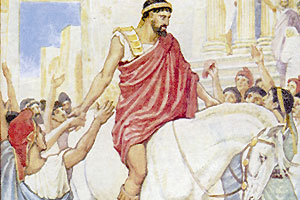When Athens was at the height of its power in the 5th Century B.C., the Greeks started to resent the loss of their autonomy, as almost all important decisions were being made in this Polis. The city which most strongly expressed this resentment was Corinth. This city called for a meeting of the Pelopennese League which was led by Sparta and made up of Thebes, Pylos, Elis, Megara and Aegina, as well as Corinth. In this meeting they resolved to attack the Athenians, and declared war against them. In response, Athens formed the League of Delos (see inbox).
Thus began the Peloponnese War (431-404 B.C.). Although all cities in Greece took part, the burden of the conflict rested upon the two rival cities: Athens and Sparta. The former asserted superiority on the sea, while the later demonstrated that it was almost invincible on land.
Stages of the war
The Peloponnese War is usually divided into 3 stages: The Invasion of Attica, The Expedition to Syracuse and The War of Decelea.
– Invasion of Attica or The 10 Year War (431 – 421 B.C.)
The war began with the Spartan invasion of the Peninsula of Attica in the Aegean Sea. The citizens of the cities allied to the League of Delos fled their cities, looking for refuge in Athens. At that moment, Archidamus, the leader of the Spartan troops, entered the city and attacked it.
At the same time, Athenian troops decided to block the delivery of food supplies by sea. Spartans, fearing death by starvation, left Athens and settled in the surrounding areas. This allowed Athenians to return to their cities, however the poor hygienic conditions which existed, worsened. This resulted in a plague in the year 430B.C. which killed a quarter of the population including Pericles himself, who died in the year 429 B.C. Cleon succeeded him in his role. Athens, meanwhile, remained a hotspot of the epidemic, meaning Spartan troops, fearing a massive contagion, kept away. Meanwhile, Athens, making use of its naval superiority, was able to counterattack in the coastal areas of the island of Sphacteria, in the Peloponnese Peninsula. Nonetheless, shortly after this victory, the King of Sparta Brasidas invaded Amphipolis, the source of Athens’ supplies. Following this Cleon decided to confront his Peloponnesian rival, but both were killed in the battle.
As a result of this, Athenian Aristocrats signed a peace treaty with Sparta, which began a period of harmony between the two Polis that had lost thousands of men and their best leaders. It was Nicias, an Athenian politician, who drew up the peace treaty which lasted 50 years.
– The expedition to Syracuse (421 – 412 B.C.)
The Peace Treaty drawn up by Nicias never took effect, since the Spartans decided to invade the city of Mantinea, an ally of Athens. Later the Athenians decided to attack the Spartan city of Syracuse. The expedition, first led by Alcibiades and then by Nicias, was made up of 134 ships and thousands of soldiers. When the expedition arrived in the area they realised that the Syracuseans had sought the help of the Spartan general Gyllipus and his allies. With this support the Athenian army was annihilated. Of the nearly thirty thousand men who arrived in Syracuse only two thousand returned to Athens.
– The War of Decelea or the Fall of Athens (411 – 404 B.C.)
While the Spartans were entrenched in Decelea, a locality near Athens from which attacks were launched on the peninsula of Attica, Alcibiades, who once again led the Athenian army, began to negotiate with his archrivals, the Persians, who offered him help in confronting the Peloponnese. Finally, however, the Persians gave their support to the Spartans who were victorious in the naval battle of Aegospotami. This led to the Spartan chief Lysander taking control of Hellespont, now known as the Dardanelles Straits, the main supply route for the Athenians. This caused famine in Athens, and the Athenians surrendered in April 404 B.C. losing all that they had gained over many years.








